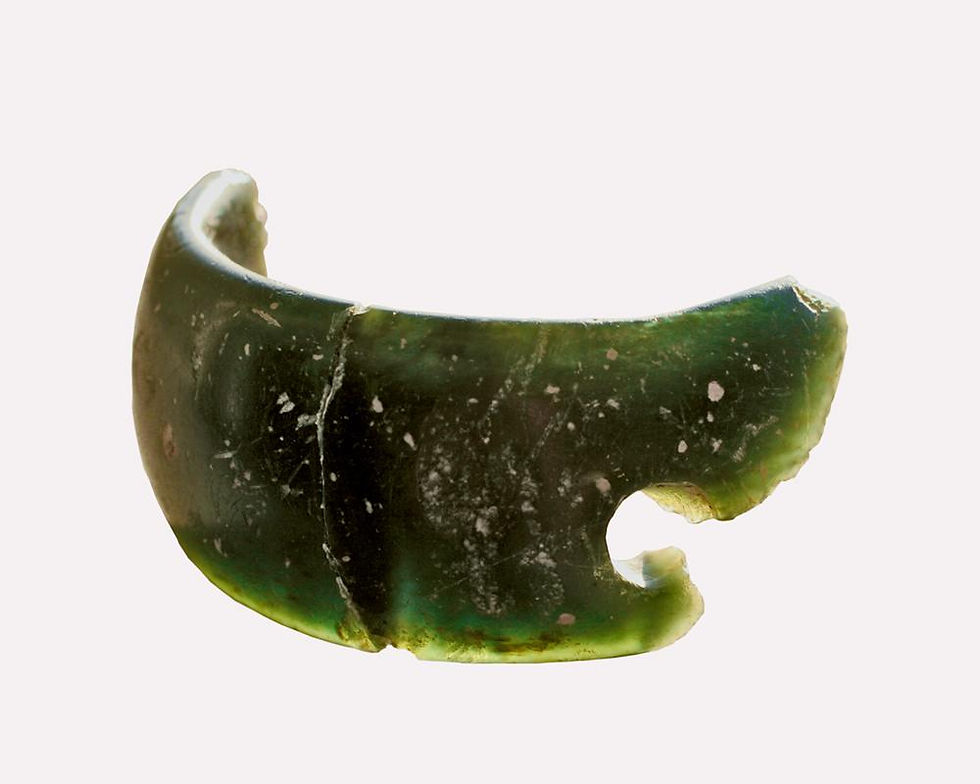The Oldest Bracelet In The World
- J.P. Robinson

- Nov 8, 2018
- 4 min read
Updated: Jan 6, 2021

In the 1970's, Soviet scientists, investigated a remarkable cave in the Altai Mountains of Siberia (above), and their discovery of important palaeo-archaeological artefacts ultimately led to the site being more thoroughly excavated in the years that followed.
Situated in the Anui River valley roughly 60 miles south of Biysk, the Denisova Cave or Aju-Tasch (which means “bear rock” in Altay), revealed over twenty layers of strata which indicated hominin occupation from the Middle Ages all the way back to 280,000 years ago. The cave got its name from Dennis (Dionisij), a hermit who lived there in the 18th century.
The presence of Acheulean, Mousterian, and Levalloisian stone-flaking industries supports the notion that 13 separate occupations were present there between 125,000 and 30,000 years ago.

Among the ancient artefacts was a fragment of a fifth digit finger bone found in 2010, which belonged to a young girl. DNA analysis from this fragment led to the discovery of an extinct species of hominin genetically distinct from Neanderthals and modern humans, now referred to as the Denisovans or homo altaiensis.
This new group are believed to have been a sister species of the Neanderthals who both lived in western Asia and Europe around the same time period. Both species are understood to have separated from a common ancestor around 200,000 years ago, whilst a split with the Homo sapiens lineage was much earlier at around 600,000 years ago.
Found in the same sedimentary layers as the Denisovan remains were bone and ivory beads suggesting that they were capable of manufacturing sophisticated jewellery and tools. For example, in 2016 a bone needle was discovered which dated to 50,000 years ago making it the most ancient needle ever found.
In 2008, two years before the discovery of the finger bone, a beautifully crafted green bracelet was dug up from the same layer as the Denisovan remains. Made from a stone called chlorite which is thought to have come from at least 200 km away from the site, the stunning bracelet is the oldest in the world of its kind.

Dr Shunkov said, 'In the same layer, where we found a Denisovan bone, we found interesting things; until then it was believed these the hallmark of the emergence of Homo sapiens. First of all, there were symbolic items, such as jewellery - including the stone bracelet as well as a ring, carved out of marble.'
'These finds were made using technological methods - boring stone, drilling with an implement, grinding - that are traditionally considered typical for a later time, and nowhere in the world they were used so early, in the palaeolithic era. At first, we connected the finds with a progressive form of modern human, and now it turned out that this was fundamentally wrong. Obviously it was Denisovans, who left these things.'
Currently kept and exhibited in Novosibirsk at the Museum of History and Culture of the Peoples of Siberia and the Far East, the unusual item was initially dated to around 40,000 years old but more recent analysis (2017) is indicative of an even earlier date of manufacture, somewhere in the region of 65,000 to 70,000 years old!
What makes the ancient bracelet especially remarkable is that the manufacturing technology employed to create a drilled hole in the stone is much more common to a later period like the Neolithic. In fact, the experts are yet to understand how the Denisovans could have made such a bracelet with the tools they had at their disposal. Of course, discovering that the ancients had access to greater technology than is currently accepted is nothing new, as I discuss in detail in my book The Myth Of Man.

Writing in the Novosibirsk magazine, Science First Hand, Dr Derevyanko explained: 'Two fragments of the bracelet of a width of 2.7cm and a thickness of 0.9 cm were found. The estimated diameter of the find was 7 cm. Near one of the cracks was a drilled hole with a diameter of about 0.8 cm. Studying them, scientists found out that the speed of rotation of the drill was rather high, fluctuations minimal, and that was there was applied drilling with an implement - technology that is common for more recent times. The ancient master was skilled in techniques previously considered not characteristic for the Palaeolithic era, such as drilling with an implement, boring tool type rasp, grinding and polishing with a leather and skins of varying degrees of tanning.'
Sceptics have suggested that such a modern-looking bracelet must have been buried with older remains, most likely buried into the cave floor at a later time to conceal it, but the experts have rejected this possibility stating that they believe the layers to be uncontaminated by human interference from a later period as the soil around the bracelet was also dated using oxygen isotopic analysis.
The bracelet isn’t the only modern looking piece of jewellery that was discovered in Denisova Cave - the team has also declared that they found other rings that were manufactured using the same technology, however, more details regarding these objects is yet to be released.
For more intriguing information on hidden history and ancient origins, read The Myth Of Man by J.P. Robinson.
Sources:
https://www.britannica.com/place/Denisova-Cave
https://www.learning-mind.com/bracelet-oldest-artifact-ever-found/
https://www.dailymail.co.uk/sciencetech/article-4753746/Scientists-believe-stone-bracelet-70-000-years-old.html
https://siberiantimes.com/science/casestudy/features/could-this-stunning-bracelet-be-65000-to-70000-years-old/









































Comments